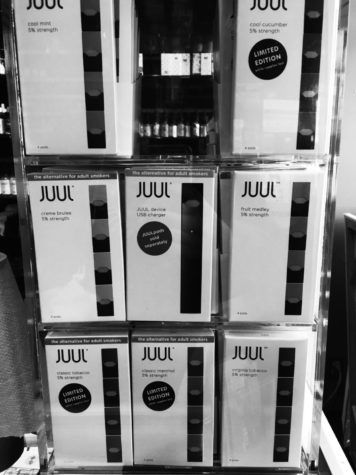Student usage of the Juul concerns Urban School health department
Posters adorn Urban’s walls with messages such as “don’t be a fuul, put down the juul,” with warnings of erectile dysfunction and the dangers of nicotine addictions. They make it clear that members of our community are aware of, and perhaps taking action against, the Juul (stylized as the JUUL). “It’s become such a big part of party culture,” said one anonymous source.
Disillusioned with the health and social implications of smoking, James Monsees and Adam Bowen set out to design a better- but still satisfying- alternative. They knew this alternative had to contain nicotine and “invite its own ritual,” according to the product’s website. They landed on the nicotine vaporizer that is known as Juul. “What we think, and what they say it would eliminate, is the combustible breathing in of smoke, of tar, and other chemicals and carcinogens,” explains Urban Health teacher Jenn Epstein.” Since its launch in 2015, hundreds of thousands of smokers have switched to Juul. This metric seems to reflect success in achieving the company’s mission of “improving the lives of the world’s one billion adult smokers.” The company directs their marketing exclusively towards existing adult smokers and warns that “those who don’t currently use nicotine products should not start.”
But Epstein questions the product’s superiority in terms of health: “I think what we’re missing is information about the chemicals that are put in the device. People are breathing that into their lungs, so is that better? We don’t know.” What we do know is that warnings of erectile dysfunction are warranted, as nicotine is a known vasoconstrictor and can cause permanent damage to blood vessels.
Epstein and members of HIPE, Urban’s Health Initiative for Peer Education, recently found a Juul pod on the ground between the Salkind Center and the Page street building. “I hear about it a ton,” Epstein says, “I’m also hearing that people are doing it in school, in class, and in the bathrooms.”
It seems that the appeal of Juuling has to do in part with the accompanying social dynamic. “I’ve seen people in groups I’ve never seen before just because they have this Juul that kind of brings them together in this weird way,” said one interviewee. It seems that gender informs the role of the Juul in social dynamics. While a female interviewee recognizes that “for guys its more of a social thing, for girls,” she says, “it’s more of a personal [independent] thing.” Some sources noted that they see boys taking deeper and harder hits than girls.
“Most dudes just rip it until the heavens open up,” said a male source, which was echoed by another: “Boys just suck that thing until they get headied out,” he said, referring to the head rush one can get by inhaling the Juul’s vapor. According to Epstein, the manner in which a substance is taken has much to do with is addictiveness: “The faster the drug gets to the brain, the more addictive it is.” For this reason, “when I hear about students having a really intense head rush,” Jenn says, “that is really concerning because nicotine is already so addictive, so when you increase that pleasure, that is going to create an even more addicting situation.”
Addiction is a reality and a concern of some students. “I have friends that have told me that they have to give theirs away because they feel like they need to hit it constantly,” said one source. “I told myself I’d never get one, because if I had one I would definitely would be addicted,” said another. Some users make rules for themselves, restricting their usage to certain parts of the week or the day or setting limits on how many times they’ll hit it within a certain time frame. “75% of teenagers who smoke become adult smokers, even if they’re doing it infrequently- they’re smoking, they’re bumming cigarettes at parties,” says Epstein. Although this statistic pertains to cigarette usage, there is not research nor evidence to deny the possibility that this holds true for electronic devices like Juul as well.
Epstein wants to better inform herself so that she can better educate our community. She went to smoke shops, including one on Haight street, to gain insight and information about the device and plans to incorporate lessons about the Juul into 9th grade health curriculum from now on. “I’m going to do a little workshop for staff and faculty about Juul and what it looks like and what it does so that teachers know to look for it, because it doesn’t look like a smoking product,” Epstein said.

Epstein looks forward to seeing the results of this year’s HIPE survey, and hopes the results will clarify how prevalent the Juul really is at Urban.











